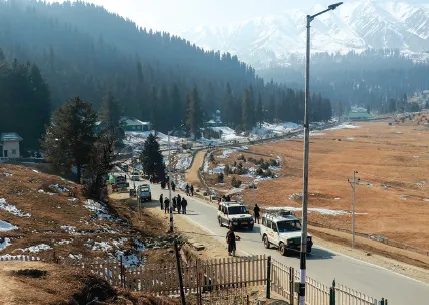The impacts of climate change are already causing damage across the globe, and Kashmir is not an exception. The winter in Kashmir was witnessed with precipitation usually in the form of snowfall; the region would get its first snowfall in the first half of December, and it continued in January.
But it has been dry this season and Jammu and Kashmir witnessed 80 per cent rainfall deficit in December and 100 per cent (absolutely no rain) deficit in January so far. The dry weather in peak winter will cause water shortage, drying up of most of the springs, shrinkage of water bodies, loss to horticultural & agricultural crops, loss of niche to large number of birds & insects and other fauna, less generation of hydroelectricity and consequently the economic loss.
The weather experts have said that the decline in Western Disturbance events, warming of sea surface temperatures has disrupted the global weather and is also one of the reasons for less rains and snow in this Himalayan region. The prevailing El Nino event in the eastern Pacific Ocean might be the additional factor to account for this year’s dry weather.
Winter precipitation in the Himalayan region is caused mainly by Western Disturbances; these are large eastward-moving rain-bearing wind systems that originate beyond Afghanistan and Iran, picking up moisture from as far as the Mediterranean Sea and even the Atlantic Ocean.
During winters, about four to six western disturbance events happen every month on an average. This season there was one feeble western disturbance event in December that did not bring any rains, and another similar one in January. The Western Disturbances, ones that definitely result in rainfall or snowfall, had declined as much as 43 per cent in recent years.
The other responsible factor is rise in temperatures; the rate of increase of temperature is seen to be higher in the upper elevation areas than in the plains. In fact, the temperatures in Kashmir this winter was sometimes equal to that of subtropical Jammu and occasionally higher than Jammu. The rise in temperature is due to global and local anthropogenic activities. It is high time to think about management of our resources and sustainable development of the region at government as
well as at the societal level.
It has been noted that the window for 1.5 degrees is rapidly closing. Every fraction of a degree matters. Every ton of carbon dioxide counts. The delegates belonging to the Alliance of Small Island States (AOSIS) emphasized that they need immediate and drastic action, not just promises and platitudes in a message to the COP28 climate meeting in Dubai.
If the condition of global climate change persisted then almost 44 small islands will be drowned and the climate of the Himalayan region is also going to change in future by these events at global level. During the last decade it is third winter without snow, researchers predicted that there might be 30% to 70% less snow by the end of this century, indicating that the changing climate in Kashmir could have long-term impacts.
The climate change will not only impact agriculture, water availability, it has several other deleterious impacts on the flora and fauna of the region as well as the lives of the people. Biodiversity, climate, and sustainable development cannot be considered in isolation. We must also factor in nature’s contributions to human well-being, including clean water, carbon storage, crop pollination, flood mitigation, coastal protection, and more.
In Kashmir we follow some practices very blindly. Recently it has been witnessed that local apple varieties have been cut down, likewise the forests have been destroyed. There is unplanned development in pristine ecosystems. All this is cause change to ecological balance and subsequently the climate. Of the most critical areas on earth for biodiversity, about 37% are also valued for development opportunities.
Conflict could arise over these land areas, which could be developed for agriculture, energy (both renewable and non-renewable), and mining. These areas are also at risk from urban development projects. The renewable energy projects are necessary to curb the worst impacts of climate change, these types of projects will need to be carefully planned and implemented in a way that minimally disrupts areas that need more conservation protections. The experts are of the opinion that renewable energy development can be compatible with biodiversity conservation and ecosystem services to people.
The process of urbanization in Kashmir is going at an alarming rate, almost all the paddy field have been converted into concrete jungles, construction work in interior of the forest land, vehicular movements up to glaciated alpines, filling up of water bodies, no marsh land and springs – which used to support rich floral and faunal diversity are at brink of extinction. We need a comprehensive and effective mechanism to address this growing challenge.
Dr. Aijaz Hassan Ganie, Dept. of Boatny, University of Kashmir, North Campus






